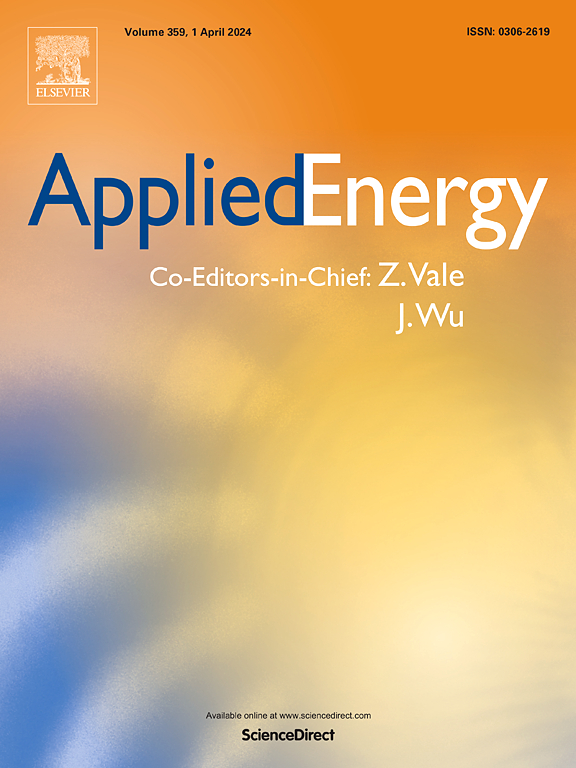空气源热泵自优化除霜启动控制器:深度强化学习的实验验证
IF 11
1区 工程技术
Q1 ENERGY & FUELS
引用次数: 0
摘要
空气源热泵(ASHPs)在可持续供暖中发挥着关键作用,但其效率因蒸发器上的结霜而显着降低。除霜启动的时间对于最小化能量损失至关重要,然而传统的基于需求的除霜(DBD)控制器依赖于专门的传感器进行霜检测和启发式除霜启动阈值,导致系统成本增加和性能不佳。提出了一种自优化深度强化学习(RL)控制器的实验验证。通过我们提出的实现方案,RL使用标准温度测量来确定除霜时间,并自动生成定制的控制规则,克服了传统DBD方法的局限性。该研究包括在一个变速源热泵硬件在环试验台上进行的三个案例研究。首先,根据实验预先确定的最优值对RL的除霜定时精度进行了评估。在五个固定测试条件下,RL实现了接近最佳的解冻启动,最大效率损失最多为1.9 %。其次,RL是根据基于时间(TBD)和基于需求的除霜控制器在不同环境条件下的三个典型日子进行基准测试的。RL在SCOP方面比TBD高出7.1 %,热输出高出3.6 %。与DBD相比,RL将SCOP提高了9.1% %,热量输出提高了4.9% %。最后,我们评估了强化学习通过在线学习调整策略的能力。我们模拟气流阻塞,这是一种常见的软故障情况,由蒸发器翅片(如叶片)上的障碍物引起。RL根据变化的环境调整策略,效率提高了16.6% %。虽然结果很有希望,但局限性仍然存在,需要进一步的研究来验证RL在真实的ashp中的应用。本文章由计算机程序翻译,如有差异,请以英文原文为准。
A self-optimizing defrost initiation controller for air-source heat pumps: Experimental validation of deep reinforcement learning
Air-source heat pumps (ASHPs) play a key role in sustainable heating, but their efficiency is significantly reduced by frost formation on the evaporator. The timing of defrost initiation is crucial to minimize energy losses, yet conventional demand-based defrosting (DBD) controllers rely on specialized sensors for frost detection and heuristic thresholds for defrost initiation, leading to increased system costs and suboptimal performance. This paper presents an experimental validation of a self-optimizing deep reinforcement learning (RL) controller. With our proposed implementation, RL determines defrost timing using standard temperature measurements and autonomously generates tailored control rules, overcoming the limitations of conventional DBD methods. The study consists of three case studies conducted on a hardware-in-the-loop test bench with a variable-speed ASHP. First, RL’s defrost timing accuracy is evaluated against experimentally pre-determined optima. Across five stationary test conditions, RL achieves near-optimal defrost initiations with maximum efficiency losses of at most 1.9 %. Second, RL is benchmarked against time-based (TBD) and demand-based defrost controllers for three typical days with varying ambient conditions. RL outperforms TBD by up to 7.1 % in and 3.6 % in heat output. Compared to DBD, RL improves by up to 9.1 % and heat output by 4.9 %. Finally, we assess RL’s ability to adapt its strategy through online learning. We emulate airflow blockage, a common soft-fault condition, caused by obstructions on the evaporator fins (e.g., leaves). RL adjusts its strategy to the changed environment and improves efficiency by 16.6 %. While the results are promising, limitations remain, requiring further research to validate RL in real-world ASHPs.
求助全文
通过发布文献求助,成功后即可免费获取论文全文。
去求助
来源期刊

Applied Energy
工程技术-工程:化工
CiteScore
21.20
自引率
10.70%
发文量
1830
审稿时长
41 days
期刊介绍:
Applied Energy serves as a platform for sharing innovations, research, development, and demonstrations in energy conversion, conservation, and sustainable energy systems. The journal covers topics such as optimal energy resource use, environmental pollutant mitigation, and energy process analysis. It welcomes original papers, review articles, technical notes, and letters to the editor. Authors are encouraged to submit manuscripts that bridge the gap between research, development, and implementation. The journal addresses a wide spectrum of topics, including fossil and renewable energy technologies, energy economics, and environmental impacts. Applied Energy also explores modeling and forecasting, conservation strategies, and the social and economic implications of energy policies, including climate change mitigation. It is complemented by the open-access journal Advances in Applied Energy.
 求助内容:
求助内容: 应助结果提醒方式:
应助结果提醒方式:


